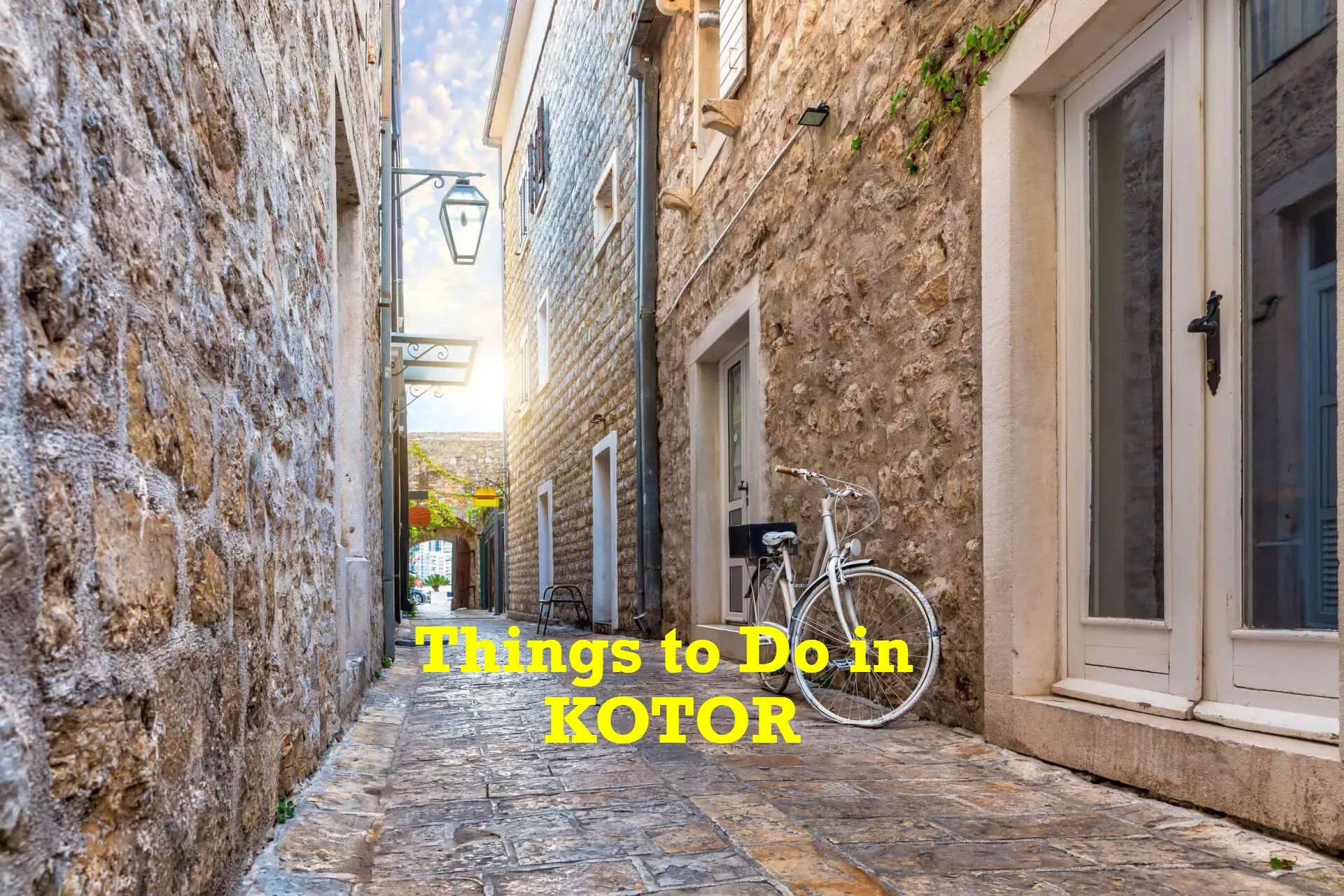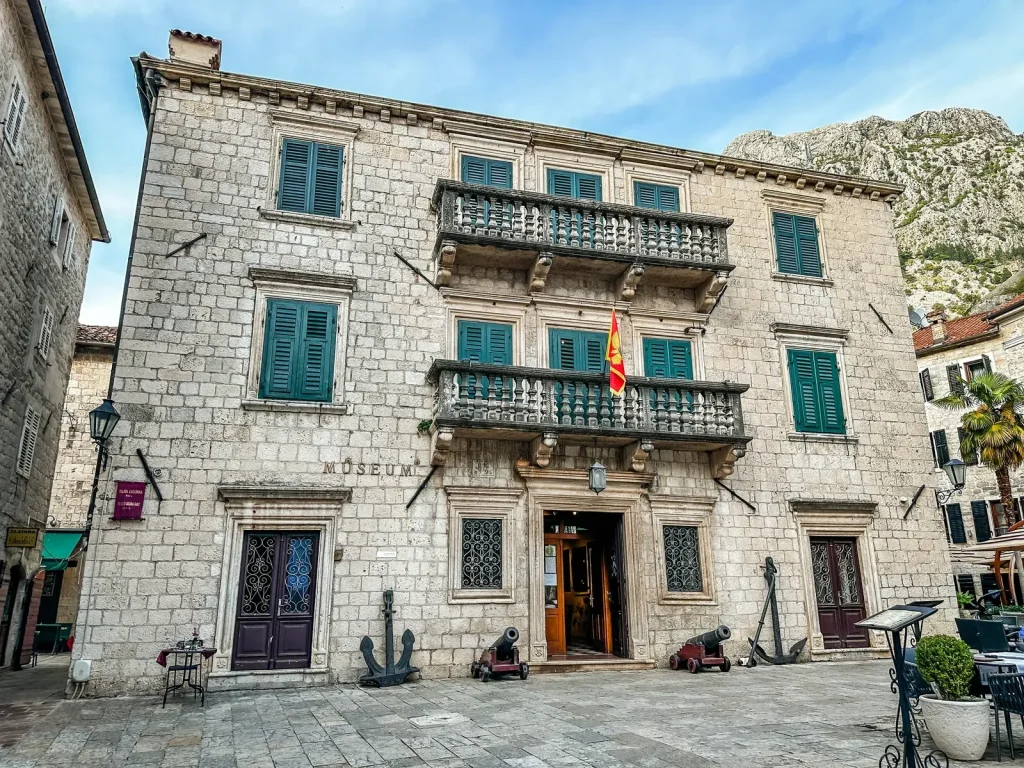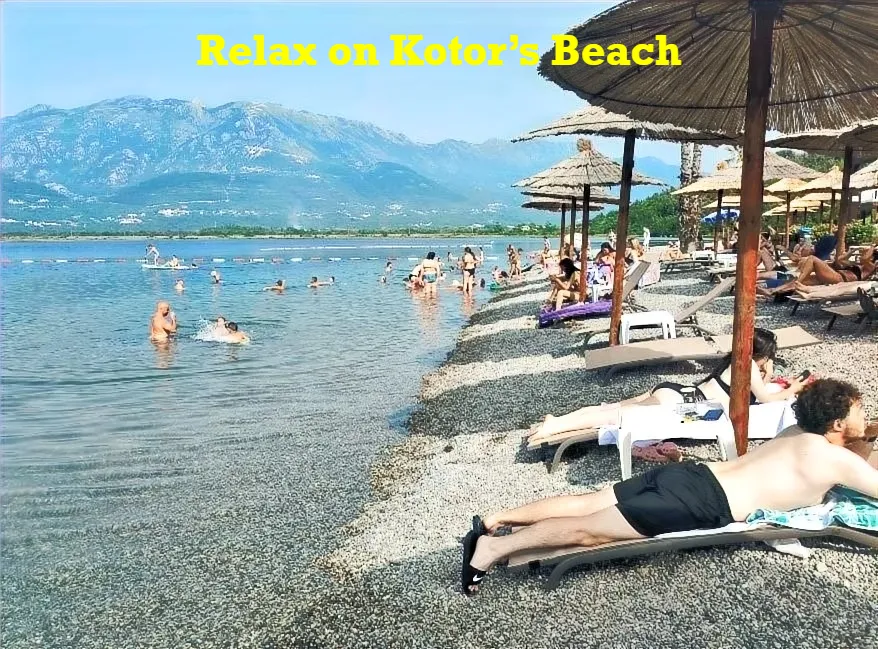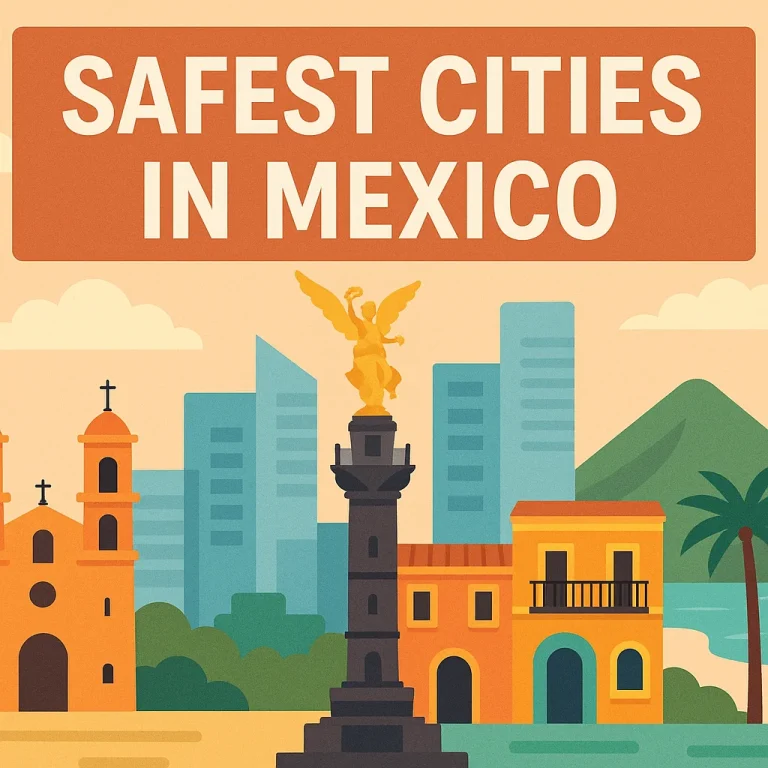15 Things to Do in Kotor

Things to Do in Kotor include hiking the 4.5-kilometer city walls, getting lost in the old town’s maze of streets, sampling local food and soaking up the picturesque views.
Start with the Cathedral of St. Tryphon, completed in 1166 (though rebuilt several times due to earthquakes) and dominating one of the main plazas.
Climb the City Walls
No trip to Kotor would be complete without a walk along its renowned city walls. These ancient walls, circling the Old Town, were first constructed in the 9th century during Byzantine rule but have been continually added to and renovated over the centuries. Climbing these central sections (not the entire 3-mile fortified loop) is a popular thing to do, especially at night when it’s a lot less crowded and when you can see the city lights twinkling out over the Bay of Kotor.
To climb the city walls, start from the north gate of the old town and head past houses until you reach a path with metal gates. From there, you can follow the wall path until it reaches a steep incline up to Saint John’s Fortress (or San Giovanni).
The views from here are some of the best in the country and it’s worth taking the extra effort to get up here at least once during your stay in Kotor. The best times to do this are May, June, and mid-September into October, when it’s not yet too hot and still green (although the weather isn’t guaranteed). The Maritime Museum is also located within the walls and has interesting exhibits about the city’s history, including gold and silver relics from ships and detailed models of local vessels.
Visit the Old Town
Kotor’s old town is a maze of alleys and squares lined with hotels, churches, cafes and tiny gardens, as well as some palatial buildings resembling those in Venice. Many are privately owned and used for residences or alternative purposes, but they’re an interesting nod to previous wealth. St Luke’s church was left relatively unscathed by the earthquake, preserving 12th-century design; and Catholic St Mary’s has a few preserved swathes of vivid 14th-century frescoes.
Several of the old town’s walls are accessible, including Gurdic Bastion, Valier Bastion and Kampana Tower on the Scurda. You’ll also want to see the Maritime Museum, a time capsule of Montenegro’s naval history that occupies three floors of a Baroque palace.
To avoid the crush of cruise ship tourists, it’s best to visit the old town early in the morning or late afternoon. Alternatively, take a short or long boat tour to the island of Our Lady of the Rocks (Island Gospa od Skrpjela), a pretty natural island with a church. You can also visit the small beach on the edge of the Dobrota neighbourhood, which offers scenic views back across the bay to Kotor.
Visit the Maritime Museum

Kotor’s municipal museum (Muzeum Podgorica) might not be everyone’s cup of tea, but it will fascinate history buffs and aficionados of the region’s naval history. Located within the early-18th-century Grgurina Palace, the museum documents Kotor’s seafaring legacy through model ships, furniture and navigational instruments.
The impressive city walls still surround the Old Town, a UNESCO World Heritage Site that’s a maze of alleyways and staircases. If you’re able to brave the crowds of cruise-ship passengers, try hiking a portion of the wall in the morning or late afternoon. The enticing hike to Saint John’s Fortress (Castle of San Giovanni) involves 1355 steps and provides epic views of the Bay of Kotor.
St Nicholas Church, a Serbian Orthodox church built in 1909, stands out with twin bell towers and an ornate iconostasis. It’s one of the best places in Kotor to experience the city’s spiritual culture. If you’re a cat lover, check out Danijela’s Shop in the old town for souvenirs that support the city’s feral cats. They’re said to be descendants of cats brought to Kotor by traders or who wandered off nearby ships.
Take a Boat Tour
Kotor’s bay is incredibly picturesque, and cruising around the waters on a boat tour is one of the best ways to enjoy it. You can book a full-day trip to visit the Blue Cave, Our Lady of the Rocks, and more from several companies.
You’ll have a hard time walking through the Old Town without admiring its medieval architecture. Start your exploration by entering through the River Gate or South Gate (Gurdic Bastion), but most visitors enter through the Sea Gate—a glistening archway dating back to 1555.
Once you’re inside, take a look at Saint Tryphon Cathedral—Montenegro’s only Roman Catholic church and an emblem of the city. The cathedral’s uneven towers are a result of earthquake damage, and its interior features beautiful frescos. You can also see two Baroque bell towers and the Sacral Arts Museum here. Taking a stroll down the pedestrian-only streets in the Old Town is another must-do. You’ll find a number of cafes and restaurants with outdoor tables perfect for people watching. Stay away from the Square of Arms, though; you’ll get better service and cheaper coffee further back into town.
Visit the Submarine Tunnels

Many of the boat trips visiting the Blue Cave will also stop by the submarine tunnels, carved into the cliffs to hide ships from spy planes. It’s a fascinating insight into the city’s history, largely tied to maritime events. The Maritime Museum is another one of the best things to do in Kotor and covers the area’s culture and history through artifacts, traditional dress and detailed models of the city’s ships and bay. It’s open daily from 8am to 11pm in July and August, and 6pm the rest of the year.
If you want to get more active and explore beyond the walls, try hiking up to Fort Vrmac from the town’s south side. It’s a steep hike but offers views over the bay that few other people experience.
The town is a great place to shop, especially for locally made arts and crafts. For souvenirs, avoid the Square of Arms near the River Gate and instead head deeper into the old town for cheaper prices and more authentic shops. If you’re a cat lover, don’t miss the stray cats of the old town, nicknamed Pjaca od Drva by locals. They’re incredibly friendly and well-fed, and many of the restaurants leave food out for them.
Take a Boat Tour of the Bay of Kotor
Get a different perspective on Kotor by cruising the bay on a three-hour boat tour. A top excursion is the Blue Cave, a spectacular rock formation that glows deep hues of blue, as well as Our Lady of the Rocks, an island church that’s a major religious destination for locals.
Other highlights include the city’s defensive walls, which cling to the mountainside and date from the 15th century; the River Gate is marked by a winged lion of St Mark for its Venetian history, while a clock tower and pyramid-shaped pillory are located nearby. Across the street is the city’s cathedral, which dates from 1166 and dominates one of Kotor’s main squares. It’s the only church in town to charge an admission fee, but you can also visit its sacral art museum upstairs.
Wander the streets of Kotor’s Old Town, which is a UNESCO World Heritage Site for its historic structures and how they harmonise with the jagged mountains that surround them. It’s best to come during the off season, but even in peak summer, you can find quiet corners in the medieval labyrinth.
Discover Perast and Our Lady of the Rocks
Located along the Bay of Kotor, Perast is one of the area’s most pristine coastal towns. Its glistening waves and dramatic mountains evoke an atmosphere of seclusion and romance. Wandering through its cobblestone streets and exploring its quaint stone churches is an excellent way to experience the town’s culture.
You may also want to consider taking a boat tour to explore the area’s islands and villages. Many cruises depart from Porto Montenegro and offer the option to visit Our Lady of the Rocks Island, Sveti Djordje Island, or both!
If you’re looking for something a little more adventurous, head to the Church of Our Lady of Remedy for a hike that includes spectacular views. This hike is around 1355 stairs and follows a section of the Old City walls steeply up to the Fortress, but you’ll be rewarded with unforgettable panoramic views over the cityscape.
Relax on Kotor’s Beaches

If you’re not a fan of cruise ship crowds, the best time to visit Kotor is in spring or fall. May through mid-September are less crowded, when the sun is out but the weather is still warm enough for boat trips and beaches.
The best way to experience Montenegro’s culture is at the local farmers’ market, which is located near the Old Town walls (best accessed via the Sea Gate). Shop for fresh vegetables and spices, homemade cheese, prosciutto, wine, and the local aperitif rakija.
While you’re here, make sure to stop by the Cat Square — aka Pjaca od Drva — which is home to a population of stray cats. You can support the cats by buying a souvenir from Danijela’s shop, which sells cat-themed items and raises money for vet care.
Experience Local Cuisine and Cafés
With its encircling mountainous bay, Montenegro’s brooding landscape is a dramatic backdrop for the atmospheric town of Kotor. The Old Town is a medieval maze of cobblestone lanes, stone churches, and café-strewn squares where past and present coexist. Lines of laundry flutter from wrought-iron balconies and local cats loll in the sun along marble laneways.
One of the most awe-inspiring things to do in Kotor is to hike to Saint John’s Fortress (also called Castle of San Giovanni). This enthralling hike follows 1355 steps up a section of the Old City walls and provides epic views of the Bay of Kotor.
Within the walls, the 16th-century Sea Garic walls, a major highlight of the city. Start your journey at the 16th-century Sea Gate, which features a winged lion of St Mark to remind visitors of Kotor’s Venetian past. You can also admire a clock tower, a pyramid-shaped pillory where wrongdoers were punished, and many other intriguing landm
te’s winged lion of St Mark recalls the city’s Venetian past. Nearby, a clock tower from 1602 stands next to a pyramid-shaped pillory where wrongdoers were publicly humiliated during the Venetian rule. The bakery here is also a must – get a meat burek for lunch.
Hike in Lovćen National Park
If you’re a hiker, you won’t want to miss the chance to visit Loven National Park. A trip to this stunning UNESCO World Heritage Site will reward you with incredible vistas, impressive marble sculptures, and so much more. You’ll also have the chance to explore a unique mausoleum atop Mount Loven. While the climb up here can be challenging, it is well worth the effort. This is a must-see for all nature lovers, history enthusiasts, and adventurers!
Shop Local Markets and Boutiques
Hemmed in by towering mountains and the picturesque Bay of Kotor, medieval Kotor’s a maze of cobblestone streets, terra-cotta tiled houses, stone churches, and cafe-strewn squares. Lines of laundry flutter from wrought iron balconies, and local cats loll lazily along marble laneways. By nightfall, the city walls glow like a halo, and behind their bulwarks, the streets bustle with bars, clubs, and live music.
While there’s plenty to see in the old town—including the 17th-century church of Our Lady of the Rocks on an artificial island—it’s best to spend two or three days here. Then you can avoid the crush of cruise ship tourists and enjoy a more leisurely exploration.
Visit the open-air market (Trg od Oruzja) near the Sea Gate, which’s stocked with locally grown fruit and vegetables, farmstead cheeses, smoked meats, and wines. You can also buy souvenirs and traditional Montenegrin clothes at boutiques throughout the old town. Be sure to try rakija, the region’s brandy-like spirit. If you’re looking for a memento, pick up a brojanica bracelet with 33 knots, the number that represents Jesus’ age when he died.
Enjoy Nightlife and Live Music
Kotor’s streets are alive with music and local charm at night time. The quaint town center offers many bars and cafes with stunning views of the bay. One of the best places to visit is Letrika, a bar known for its live DJ performances and party atmosphere.
If you’re looking for a more peaceful experience, take a stroll through the narrow streets of Kotor’s Old Town and enjoy the unique architecture. Several souvenir markets are scattered throughout the city, offering everything from handmade jewelry to traditional Montenegrin clothing. There are also countless bakeries, where you can get a meat burek (a sandwich filled with grilled beef and cheese) for around seven euros.
Another highlight is the Church of Our Lady of the Rocks, located on a manmade island in Perast. The boat ride to the island takes you past gorgeous scenery, and once you arrive, you can explore the pretty church and see its religious artifacts.
Tips for Visiting Kotor
A visit to Kotor’s Old Town is the best way to get a feel for the country’s culture and history. It’s a UNESCO World Heritage Site and is renowned for being one of Europe’s most well-preserved medieval towns. It’s a maze of cobblestone streets and narrow alleyways that lead to hidden cafes and other gems.
The Maritime Museum in Kotor is a small but fascinating museum with displays on maritime culture and traditions. It’s also home to beautiful furniture and artwork, including paintings by local artists.
The Cathedral of Saint Tryphon is another must-see. It was erected in the 12th century and is a striking structure that’s well worth a look inside. If the church isn’t too busy, walk out onto the balcony for lovely views of the empty square below. If you’re a cat lover, you can visit Danijela’s shop where she sells souvenirs to help support the city’s strays. She’s been feeding them for over 15 years.
Best Time to Visit Kotor
Kotor’s fortress walls look especially dramatic at night, lit up with a mix of colors and patterns. Stroll around the waterfront to admire the epic San Giovanni Fortress and take some spectacular photos.
The Church of Our Lady of the Rocks (Gospa od Skrpjela) is another major draw, perched on a manmade island in the bay. Tours run in summer to bring visitors here by boat for a closer look at the church, which holds religious artifacts and paintings.
Explore the town’s rich history at the Maritime Museum, where you’ll find wooden models of boats and some fascinating maritime-focused paintings. You can also admire a collection of weapons and learn more about the city’s seafaring past at the Cathedral of Saint Tryphon.
For a more low-key activity, stroll the streets in Old Town to visit Cat Square (Pjaca od Drva). The square is strewn with cute stray cats, and local Danijela has opened a cafe to support the cat population. She sells souvenirs, including cat-themed postcards and stuffed animals. You can also purchase Montenegrin wines, like the rich Varnac, at her shop.
Stroll the Kotor City Walls
Built between the 9th and 14th centuries by both the Illyrians and the Venetians, Kotor’s city walls remain intact. They surround the old town and enclose forts, gates, and churches including cavernous St Eustace’s Cathedral that boasts 18th-century frescoes and gold treasures.
Climbing the 1,350 steps up to the fortress of St John offers a breathtaking view over the Bay of Kotor. The serpentine path up the hill was a strategic design meant to confuse attackers.
Depending on the season, you might be able to pick up snacks or more souvenirs at Kotor’s outdoor market. For drinks, head to Letrika Bar, Nitrox Pub, or Bandiera Authentic Pub. They’re all great places to clink your glasses and toast another day in one of the most beautiful cities in the Balkans.
